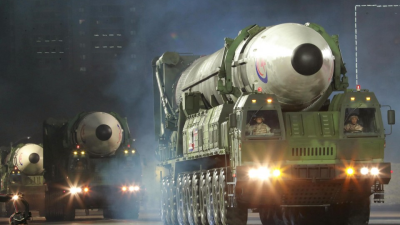US nuke legacy leaves Marshall Islanders ‘in exile even in death’

When Alson Kelen, a former municipality chief on the Pacific island of Bikini Atoll that was the site of a U.S. hydrogen bomb detonation on March 1, 1954, recalls how his mother used to pine for returning to her homeland, it still brings up strong feelings.
After her death in 2020 on Ejit Island, a Marshall island located around 800 kilometers to the south of Bikini, she joined many others who were ultimately unable to move back within their lifetimes.
Bikini’s 167 former residents, including Kelen’s mother, Lirok Joash, were forced to leave the atoll in March 1946, before the United States conducted a nuclear test dubbed “Castle Bravo” and 66 other nuclear experiments on the Marshall Islands from 1946 to 1958.
Joash would often ask Kelen when they could return to Bikini, a place where she had fond memories of going fishing and making handicrafts from coconut.
“I told her the truth: ‘I don’t know.’ And of course, at the same time, I was lying…I know we’re not going back,” he told Kyodo News recently, adding that he did it to protect his mother’s feelings.
In 1969, the United States finally declared that Bikini was safe to move back to. But Joash only returned to the island once with Kelen, who was born in Kwajalein Atoll, as it was later revealed that high levels of radiation contamination remained on the island, and several residents suffered from exposure.
Joash and Kelen were therefore forced to leave Bikini again in 1978. After moving to Kili Island and then Majuro, the country’s capital, they settled in nearby Ejit more than four decades ago.
Joash died from natural causes at 95, but according to Kelen, she was always wary of the contamination on Bikini. One day, he hopes to grant his mother’s wish by bringing her remains, laid to rest at the cemetery in Ejit, to Bikini.
Many people from four severely affected Marshall Islands atolls — Bikini, Enewetak, Rongelap and Utrok — continue to feel as though they are “in exile even in death,” as described by President Hilda Heine in a recent interview with Kyodo, highlighting the lingering effects of radiation on the islands.
Of the 167 Bikinians displaced in March 1946 in preparation for the nuclear tests, only seven remain alive, according to Jess Gasper Jr., a senator who represents Bikini Atoll.
Ejit municipal council member Frederick Aitab said that most of the deceased Bikinians on Ejit, including the offspring of the 167 displaced, have died from cancer, though whether the deaths are linked to radiation exposure has not yet been established.
The Government Accountability Office, a U.S. government watchdog, wrote in a report submitted to a U.S. Senate environment committee in January that some parts of Bikini Atoll still have high levels of radiological contamination.
Citing a 2016 Proceedings of the National Academy of Sciences article, the watchdog wrote that gamma radiation levels on Bikini remained at more than 1 millisievert per year, much higher than the 0.095 millisieverts found in natural background radiation elsewhere in the Marshall Islands.
On Rongelap Atoll, which saw significant radioactive fallout after the Castle Bravo test, some parts have been blighted by radiological contamination, the office’s report said, citing the scientific studies in its review.
From the 1970s to the 2000s, the United States conducted cleanup operations at the Bikini, Enewetak and Rongelap atolls, and it continues radiological monitoring of them alongside Utrok Atoll, the report said.
Bikini is still uninhabited due to radiation fears, and there are no regular flights or ships to the atoll.
On Rongelap, where all residents were evacuated to until 1985, the government constructed housing and basic infrastructure after the United States finished its cleanup operations.
But its former residents did not return due to nuclear contamination concerns, and because many of those who were exposed to the radioactive fallout from the Castle Bravo test suffered serious health problems, said James Matayoshi, the mayor of Rongelap.
While Matayoshi said that the residential area where contaminated earth was removed is safe, he acknowledged a study by Columbia University published in 2019 that showed the radiation level in the northern part of the atoll was still high.
He also admitted that there are few ways to make a living at Rongelap, given coconuts harvested at the atoll were feared by some people in Majuro to be unsafe to process and sell.
The mayor, who lives in Majuro, said his family members and relatives died in the capital, and that their remains have been laid to rest on the premises of his house.
“We have a cemetery where a lot of our elders and families have been buried (on Rongelap),” Matayoshi said, explaining that his late mother, aunts and cousins have said they wish to join their ancestors at the cemetery.
But he added that it would be difficult to bring their remains to Rongelap, about 700 kilometers away from Majuro, due to the costs involved and a lack of frequent flights.
Meanwhile, Kelen, 55, said that given Bikini remains uninhabitable, he may ask his grandchildren to move his mother’s remains from a cemetery on Ejit to Bikini, so that he can make her wish come true even if he ends up being unable to do so while he is alive.
David Anitok, a senator who represents Ailuk Atoll and Presidential Envoy for Nuclear Justice and Human Rights, said the people of the Marshall Islands must continue to remember those who have died without being able to return home, and should continue striving to seek justice for them.
When asked how meaningful it is for Marshall Islanders to be buried on the islands they call home, he said, “Land…is part of who we are, it’s our identity. And losing our homeland is really losing who we are as a people.”




